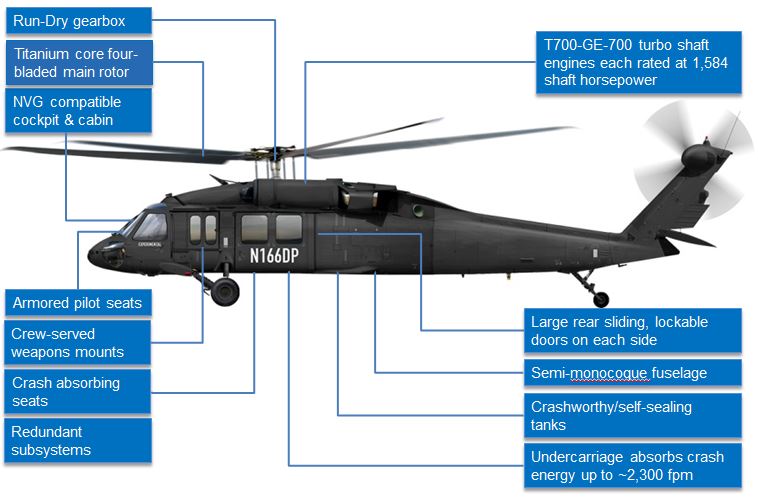Grasping the Skies: UH 60 Helicopter Upkeep Checklist
Grasping the Skies: UH 60 Helicopter Upkeep Checklist
Blog Article
Comprehending the Mechanics and Design Behind Uh 60 Helicopters
The UH-60 helicopter, commonly known as the Black Hawk, stands as a peak of contemporary rotorcraft modern technology, symbolizing a blend of durable engineering and complex auto mechanics. As we peel back the layers of the UH-60's layout, a globe of detailed systems and meticulous design comes to light.
Background of UH-60 Helicopters
The background of UH-60 helicopters traces back to the late 1970s when the United States Military sought a versatile and advanced energy helicopter to change its aging fleet. In reaction to this demand, the Sikorsky Aircraft Corporation established the UH-60 Black Hawk helicopter. Introduced in 1979, the UH-60 quickly came to be a staple in armed forces operations as a result of its impressive capabilities.
The UH-60 was made to master a range of missions, consisting of army transport, clinical discharge, electronic war, and special procedures. Its capacity to adapt to various roles made it a valuable property to the united state Army and various other army forces all over the world
For many years, the UH-60 system has actually gone through a number of upgrades and variations to boost its efficiency and equal advancing objective needs. These helicopters have seen considerable service in disputes such as the Gulf Battle, Afghanistan, and Iraq, showcasing their reliability and versatility in varied functional atmospheres. The UH-60's rich history is a testimony to its long-lasting tradition as a leading energy helicopter.

Engine and Power Systems
Using sophisticated propulsion technology, UH-60 helicopters are furnished with advanced engine and power systems to ensure ideal efficiency and reliability in a variety of functional situations. The UH-60, commonly understood as the Black Hawk, is powered by two General Electric T700-GE-701D engines, each capable of providing up to 1,940 shaft horse power. These turboshaft engines supply the required thrust for the helicopter to accomplish its objectives successfully, including troop transport, medical discharge, and fight assistance.

Rotor System and Aerodynamics
Exactly how do the blades system and aerodynamics of UH-60 helicopters contribute to their functional performance and flight abilities? The rotor system of the UH-60 helicopter plays a vital role in offering lift and propulsion.
Aerodynamics also play a key function in the efficiency of UH-60 helicopters. The structured body and blades blade design minimize drag, enabling the helicopter to accomplish higher rates and better fuel efficiency. The wind resistant layout of the UH-60 additionally contributes to its capability to run in varied environmental conditions, consisting of warm temperature levels and high altitudes.
Avionics and Flight Control Systems

In its detailed sychronisation with the rotor system and aerodynamics of UH-60 helicopters, the avionics and flight control systems develop an important network of modern technologies shaping the aircraft's functional capabilities. Avionics encompass the electronic systems used for interaction, navigation, and keeping track of numerous airplane functions. In the UH-60, these systems include electronic display screens, communication radios, GPS navigating, weather condition radar, and autopilot systems. These avionics systems supply important info to the pilots, boosting situational understanding and making certain safe and efficient operation of the helicopter.
The flight control systems of the UH-60 are accountable for converting the pilot's inputs into the appropriate modifications to the rotor system, ensuring stable flight and ability to move. These systems are composed of hydraulic actuators, servos, and computer systems that collaborate to control the tail and primary blades, as well as various other flight control surfaces. By exactly handling the helicopter's trip dynamics, these systems allow pilots to carry out a wide variety of objectives, from transportation and search-and-rescue to combat operations, with accuracy and confidence.
Role and Applications in Aeronautics
The role and applications of avionics and trip control systems in aeronautics are indispensable to making certain the efficient and risk-free procedure of aircraft, consisting of UH-60 helicopters. Avionics systems in UH-60 helicopters encompass a series of electronic systems that help in navigation, communication, monitoring, and regulating various aircraft features. These systems include electronic screens, auto-pilot systems, interaction radios, general practitioner navigation equipment, and weather condition radar. Trip control systems play a critical role in steering the helicopter airborne, keeping stability, and ensuring specific activities. The fly-by-wire technology utilized in modern-day UH-60 helicopters converts pilot inputs right into electronic signals, which are then translated by the trip control computers to adjust the aircraft's control surface areas. Furthermore, these systems integrate safety and security functions such as autopilot modes, surface understanding warning systems, and security enhancement systems to improve the total safety and operational capabilities of the visit here UH-60 helicopters in various goals, consisting of troop transport, medical discharge, search and rescue, and airborne firefighting.
Verdict
In verdict, the UH-60 helicopter is a versatile aircraft with a rich history and advanced design. Its engine and More Help power systems, rotor system, the rules of aerodynamics, avionics, and flight control systems all work together to make it a efficient and trusted equipment.
In its intricate sychronisation with the rotor system and aerodynamics of UH-60 helicopters, the avionics and trip control systems form a critical network of modern technologies forming the airplane's functional capabilities.The flight control systems of the UH-60 are liable for converting the pilot's inputs into the suitable adjustments to the blades system, ensuring secure trip and ability to move. Avionics systems in UH-60 helicopters incorporate a variety of digital systems that help in navigation, interaction, monitoring, and regulating different aircraft functions. In addition, these systems incorporate safety and security attributes such as auto-pilot settings, terrain understanding cautioning systems, and stability augmentation systems to enhance the general safety and security and operational capacities of the UH-60 helicopters in numerous objectives, including troop transport, clinical evacuation, search and rescue, click this and aerial firefighting.
Its engine and power systems, rotor system, the rules of aerodynamics, avionics, and flight control systems all work together to make it a effective and trusted device.
Report this page